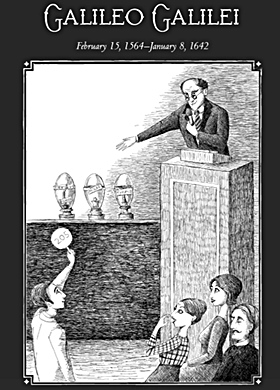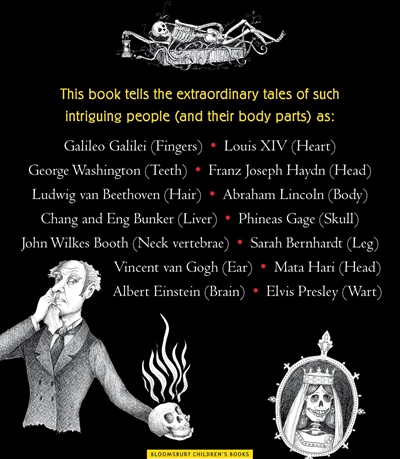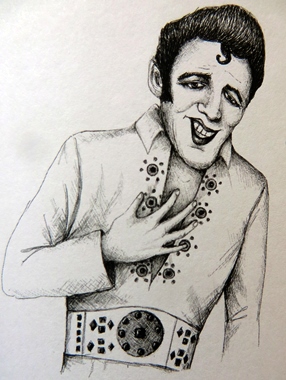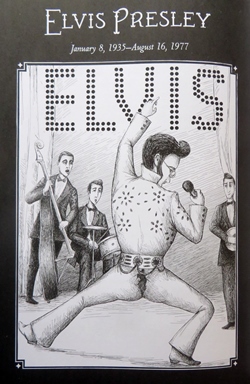'They lost their heads! What happened to Washington’s teeth, Einstein’s brain, (Elvis' wart) and other famous body parts'
By Carlyn Beccia
Book Review by Susan MacDougall
|
From the book's publicity .. “From the kidnapping of Einstein's brain to the horrifying end of Louis XIV's heart, the mysteries surrounding some of history's most famous body parts range from medical to macabre. Carlyn Beccia explores the misadventures of noteworthy body parts through history and springboards to exploring STEM topics such as forensics, DNA testing, brain science, organ donation, and cloning. The engaging tone, wonderfully creepy subject matter, and delightfully detailed art are sure to capture even the most reluctant readers.
The famous people and their body parts include:
Galileo Galilei / Fingers
Louis XIV / Heart
George Washington / Teeth
Sarah Bernhardt / Leg
Vincent Van Gogh / Ear
Mata Hari / Head
Albert Einstein / Brain
Elvis Presley / Wart
Thomas Edison / Last Breath.
EIN book reviewer Susan MacDougall explores this weird book - will Elvis get a fair representation after all these years... |
 |
Susan MacDougall's review proving that EIN keeps a watch out for ELVIS in nearly every publication! |
They lost their heads! What happened to Washington’s teeth, Einstein’s brain, and other famous body parts by Carlyn Beccia, Bloomsbury, New York, 2018. Ill., sources, biographies, index. ISBN 978-0-8027-3745-8
When I saw the blurb, I thought that this might be a book to bring in more Elvis fans. Was I right?
Aimed at 10 to 14 year-olds, it is described as a fun way to educate children about forensic science, genetics and DNA. What has happened to body parts of various famous people after, and even before death, is used by way of illustration. Examples include Galileo, King Louis XIV, George Washington, Franz Joseph Haydn, Ludwig van Beethoven, Abraham Lincoln, Sarah Bernhardt, Vincent van Gogh, Mata Hari, Albert Einstein, Thomas Edison -- and Elvis Presley.
The somewhat macabre contents include information and anecdotes concerning the dying process, decomposition of the body, cannibalism, body preservation, conjoined twins, tissue and organ transplants, body snatching and kidnapping, souveniring of body parts, castration, phrenology, hair jewellery, DNA testing, vampires, electric shock treatment, cryonics and cloning.
The book is written in a facetious manner intended to appeal to children. The illustrations are cartoons.
Beccia provides “fun facts” relating to the relative lengths of time bodies take to be reduced to skeletons, depending on whether they are buried, immersed in water or exposed to the air. Intestines are the first to rot, the brain next, and teeth and bones the last.
The book starts with love stories where a partner could not bear to part from his/her beloved, even when dead, and kept the body or a part of it at hand. For example, Juan Peron kept his wife Eva Peron’s embalmed corpse in the dining room where he ate.
Other miscellaneous interesting facts: -
• Percy Bysshe Shelley’s heart wouldn’t burn when his body was cremated, so it was kept and given to his wife Mary Wollstonecraft Shelly.
• When Galileo died, people souvenired his vertebra, fingers, and one of his molars.
• After Haydn’s head was stolen and replaced with another, his body ending up with two heads in the grave.
• The snatching of bodies to sell to medical schools became so common by 1850 that six to seven hundred bodies were being stolen yearly from New York graves.
• George Washington had great trouble with his teeth.
• People wanted a piece of Beethoven’s hair as a souvenir, much as people might collect autographs today.
• Analyses of hair samples show that Beethoven suffered from lead poisoning, Edgar Allan Poe from arsenic poisoning.
• Alexander the Great’s body was preserved in a vat of honey, while Horatio Nelson was pickled in a cask of brandy until his body could be brought on land.
 |
Some of the illustrations are kinder than others!
So how does this publication relate to Elvis Presley? The chapter on Elvis is called Elvis Presley: warts and all. Joni Mabe collected more than thirty thousand Elvis artifacts for her Panoramic Encyclopedia of Everything Elvis. The pride of her collection is “one hunk, a hunk of burning wart”.
Beccia repeats the old stereotypes about Elvis’s unhealthy diet and lifestyle. At the same time, a DNA test of Elvis’s hair revealed that he had real health problems: hypertrophic cardiomyopathy, and genes associated with glaucoma, migraines and obesity. The technique of cloning and stem cells is described, but trying to clone Elvis by cloning his wart would result in cloning a virus, not Elvis himself.
Carlyn Beccia's noted sources are Wilborn Hampton’s Elvis Presley; Pamela Clarke Keogh’s Elvis Presley: the man, the life, the legend; James D. Watson & Andrew Berry’s DNA: the secret of life; and Peter Guralnick’s Careless Love (the unmaking of Elvis Presley). Her quotes in the text are taken from Joni Mabe’s online Panoramic Museum of Everything Elvis which is available online on Youtube.
The fact that Carlyn Beccia only considered volume 2 of Guralnick's Elvis biography - his later life - suggests that she was looking for selected facts that suited the tone and style of her publication. She obviously wasn't after a balanced assessment of Elvis as a person, and from her writing it would be surprising if Beccia even read Guralnick’s very solid work from cover to cover.
Einstein apparently ate greasy sausages and chocolate-covered ice cream cones that must surely have adversely affected his health too. But it’s Einstein’s brain that’s been the centre of attention to ascertain whether the brain structure could explain his genius (did he have any warts?). The corpus collosum is a bunch of fibres connecting the left and right sides of the brain. These fibres allow the left and right hand sides of the brain to work together. Einstein’s brain contained an unusually large bunch of these fibres. Scientists still aren’t sure if this is the reason for his great intellect.
The body of Queen Nfertiti of Egypt cannot be identified by DNA testing because of the “rampant” inbreeding between the Egyptian royals, muddying the gene pool. At least we know where Elvis’s wart is and what it can’t say about his DNA.
The answer to the question in the title “What happened to Washington’s teeth, Einstein’s brain, and other famous body parts?” is that some are in museums and public or private collections, others ended up in buckets in hospitals, burned, buried, thrown away or lost.
This same style of educating children with humour is evident too in the British Horrible Histories television series and in Nasty Nature in the British Horrible Science series.
David Attenborough’s programs provide more information about animal behaviour without mocking them. I think his programs also appeal to children of all ages without reinforcing stereotypes.
In conclusion
This book uses famous people to illustrate forensic science, but often quotes quirky facts, thereby downplaying their achievements and contribution to the world – especially in Elvis’s case. The chapter on Elvis has a facetious and mocking tone, the portrayal of Elvis does him a disservice It shows a back-view caricature view of Elvis in a jumpsuit with split pants. It’s most unlikely to encourage anyone to become an Elvis fan.
It's taken a long time for Elvis’ talent and achievements to be better appreciated and while this could be a set-back, it probably won't be.
Not recommended for you or your children. It’s his singing talent and compassion for others that matters. Yes, science is important, but is this the right way to teach it?
Review by Susan MacDougall.
-Copyright EIN June 2018 - DO NOT COPY -
EIN Website content © Copyright the Elvis Information Network.
Comment on this review
GO HERE to SUSAN MACDOUGALL's EIN Book-Page to check out all her reviews
 |
'The Million Dollar Quartet’ Book Review: 'The Million Dollar Quartet’ is the name given to the impromptu jam session among Elvis Presley, Jerry Lee Lewis, Carl Perkins, and Johnny Cash on December 4th 1956.
This book by Stephen Miller - from 2013 - includes interviews with the drummer and the sound engineer.
It features a detailed analysis of the music played – and its relevance to subsequent popular music.
The early lives and careers of the quartet – where they were in 1956.
Relevant social and economic factors which meant that a massive audience of young people were keenly looking for a new kind of music they could call their own.
The “reunions” of surviving members of the quartet.
The emergence of the tapes, first on bootleg and then on legitimate CDs.
The genesis of the stage show and its reception – the enduring appeal of the music.
Go here as EIN book reviewer Susan MacDougall explores this detailed look into a jam session that Elvis fans all know so well... is there really any more to discover?
(Book Reviews, Source;SMacDougall/ElvisInformationNetwork)
|
 |
'The Seeker King' - Book Review: A woman in the audience once handed Elvis a crown saying, "You're the King." "No, honey," Elvis replied. "There is only one king -- Jesus Christ. I'm just a singer."
In his 2013 book 'The Seeker King: a spiritual biography of Elvis Presley' author Gary Tillery presents a coherent view of Elvis's thoughts through such anecdotes and other recorded facts. Elvis came to believe that the Christ shines in everyone and that God wanted him to use his light to uplift people. And so he did. Elvis's excesses were as legendary as his generosity, yet, despite his lethal reliance on drugs, he remained ever spiritually curious. This intimate, objective portrait inspires new admiration for the flawed but exceptional man who said, "All I want is to know and experience God. I'm a searcher, that's what I'm all about."
EIN book reviewer Susan MacDougall explores this interesting book and questions that since so much has been written about Elvis' including at least a dozen books about his spiritual search, is there anything new to say? Go here to read her detailed review to find out!
(Book Reviews, Source;SMacDougall/ElvisInformationNetwork)
|
 |
'The Death and Resurrection of Elvis Presley' - Book Review: Elvis Aaron Presley is more popular today than ever, yet he died nearly forty years ago. His music is constantly remixed and re-released to a new generation of fans, and his image thrives in popular art and culture. Elvis is the subject of some truly astonishing rumours and legends, including the one that he never actually died. In the new book, The Death and Resurrection of Elvis Presley, author Ted Harrison asks what lies behind the remarkable resurrection in popular culture of the King of Rock 'n' Roll. It tells the story of Elvis after Elvis. It shows how his estate, which was pillaged by his manager, was saved through the business acumen and financial vision of his ex-wife Priscilla Presley. It explores a spiritual dimension to the Elvis revival, where fans create a fantasy quasi-religion through which they blend and confuse Elvis and Jesus.
Published in 2016 this is a thoroughly researched book that brings us up-to-date with recent developments. Harrison draws on existing publications on the same topic, as well as websites and correspondence, conversations and interviews with many Elvis fans and associates conducted over 25 years, to make a well-argued case. He finally proposes possible future directions for this extraordinary Elvis phenomenon.
Go here as EIN book review Susan MacDougall explores this fascinating book and decides whether Elvis fans need to discover what the myth is all about.
(Book Reviews, Source;SMacDougall/ElvisInformationNetwork) |
 |
'Down At The End Of Lonely Street' - Book Review: This 1997 published fan favourite 'Down at the End of Lonely Street: The Life and Death of Elvis Presley'
promised an "intimate portrait of Elvis Presley, America’s favorite music idol, chronicling his remarkable life from a dirt-poor schoolboy in Memphis through his rise as a Rock n’ Roll superstar to his final days in Las Vegas. Drawing on exclusive interviews with Elvis’s closest friends and new documentary evidence, this biography reveals secrets about his relationships with his addictive mother Gladys, his ruthless manager Colonel Tom Parker, his musical rivals The Beatles, and the truth behind his marriage to Priscilla Beaulieu."
EIN reviewer Susan MacDougall checks out this old classic to see how it stands the test of time, look at some of the interesting issues addressed and investigates how the book sees Elvis as a "person" rather than an image.
(Book Review, Source: EIN, January 2016) |
 |
'Nashville Chrome' - Book Review: In the late fifties the Country Music group The Browns - Maxine, Bonnie, and Jim Ed - were enjoying unprecedented international success, rivaled only by their longtime friend Elvis Presley. The book 'Nashville Chrome' by author Rick Bass presents a vivid evocation of an era in American music, while at its heart it is a wrenching meditation on the complexities of fame and of one family who experienced them firsthand.
Just two months ago it was announced that The Browns would be inducted into Country Music Hall of Fame. With immaculate timing, EIN contributor Susan McDougall reviews the 2010 publication 'Nashville Chrome' about this fascinating group.
The connection between The Browns and Elvis is an intersting topic - and as always Susan presents both the positives and negatives about publishing a book about such a well-researched period.
Read Susan's full review
(Book Review, Source: EIN, May 2015) |
 |
EIN Website content © Copyright the Elvis Information Network.
Elvis Presley, Elvis and Graceland are trademarks of Elvis Presley Enterprises.
The Elvis Information Network has been running since 1986 and is an EPE officially recognised Elvis fan club.
.
. |














